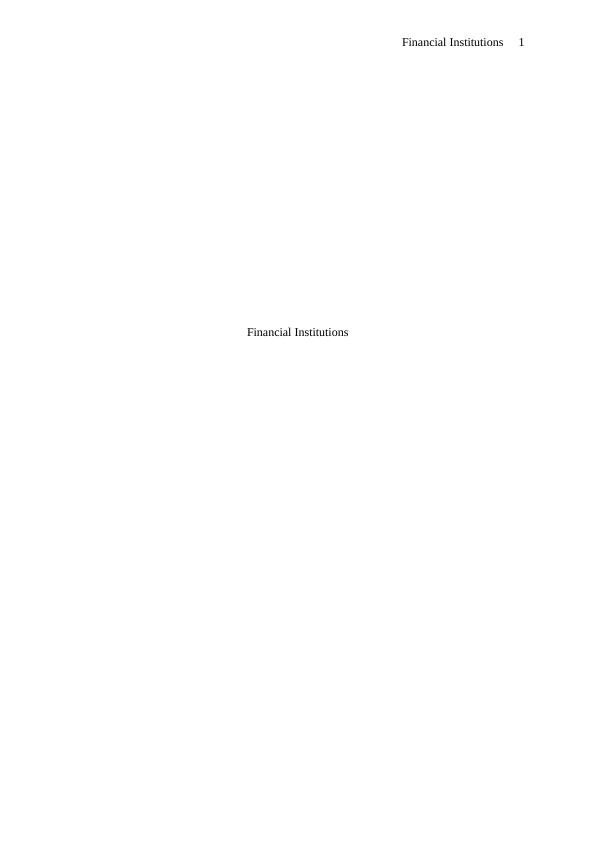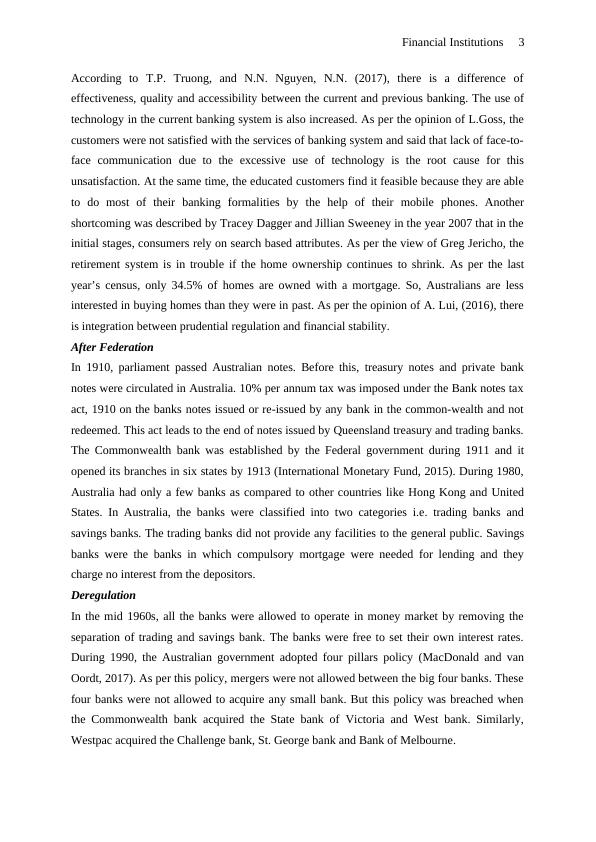Financial Institutions Assignment | Banking System
Added on 2020-04-01
10 Pages3851 Words53 Views
Financial Institutions 1Financial Institutions

Financial Institutions 2IntroductionThis essay is based on the banking system of Australia. This essay contains past, present andfuture regulation of Australian banks. This essay describes the establishment of first bank inAustralia and the years when the first bank of Australia opened its branches across Australia,the major four banks of Australia and the sum total of domestic assets with them, the fourregulatory bodies and their roles and responsibilities in the development of banking systemand the economy of Australia, central bank of Australia and the monetary policy tools withthe central bank, a table of exchange rates of Reserve bank of Australia (Adapa and Roy,2017). This essay contains history of almost all the banks of Australia and some factors arealso discussed which can affect the growth of banking system in future.ResearchBefore 1817, there were no banks in Australia. According to Bryan Fitz-Gibbon and MarianneGizycki, the first bank of Australia was the Bank of New South Wales. In 1817, this bank wasestablished in Sydney. The bank opened its branches during nineteenth and early twentiethcentury across Australia and Oceania. The first branch of this bank was opened in 1850 atMorton Bay. Second branch was established in 1851 in Victoria then third branch was openedin 1861 in New Zealand, fourth branch was established in 1877 in South Australia, fifthbranch was established in 1883 in Western Australia, the sixth branch was established in Fiziin 1901 and the seventh branch was established in Tasmania in 1910 (Ahmed and Ndayisaba,2016). After this, the Commercial banking company of Sydney was established. The nextbank after the Commercial banking company of Sydney was the National bank of Australasia.This bank was established in 1858 and later opened its branches in Tasmania in 1859,Western Australia in 1866, New South Wales in 1885, Queensland in 1920 and London bankin 1864. In the opinion of G.D. Carnegie in 2016, the National Commercial bankingcorporation of Australia was formed with the merger of the Commercial banking companyand the National bank of Australasia. This bank was later renamed as the National Australianbank (Hudson, et al., 2017). During 1960s, Australian banks have adopted new technologiesin order to reduce operating costs. In Australia, automated teller machine (ATM’s)commenced in 1969. The largest five banks which are using a number of automated tellermachine were: the NAB-redi ATM with over 3400 machines, ANZ with over 2600 machines,the Commonwealth bank-Bank west network with over 4000 machines, Suncorp with over2000 machines and Westpac-St.george-Bank SA and Bank of Melbourne with over 3000machines (The Conversation, 2016).

Financial Institutions 3According to T.P. Truong, and N.N. Nguyen, N.N. (2017), there is a difference ofeffectiveness, quality and accessibility between the current and previous banking. The use oftechnology in the current banking system is also increased. As per the opinion of L.Goss, thecustomers were not satisfied with the services of banking system and said that lack of face-to-face communication due to the excessive use of technology is the root cause for thisunsatisfaction. At the same time, the educated customers find it feasible because they are ableto do most of their banking formalities by the help of their mobile phones. Anothershortcoming was described by Tracey Dagger and Jillian Sweeney in the year 2007 that in theinitial stages, consumers rely on search based attributes. As per the view of Greg Jericho, theretirement system is in trouble if the home ownership continues to shrink. As per the lastyear’s census, only 34.5% of homes are owned with a mortgage. So, Australians are lessinterested in buying homes than they were in past. As per the opinion of A. Lui, (2016), thereis integration between prudential regulation and financial stability.After FederationIn 1910, parliament passed Australian notes. Before this, treasury notes and private banknotes were circulated in Australia. 10% per annum tax was imposed under the Bank notes taxact, 1910 on the banks notes issued or re-issued by any bank in the common-wealth and notredeemed. This act leads to the end of notes issued by Queensland treasury and trading banks.The Commonwealth bank was established by the Federal government during 1911 and itopened its branches in six states by 1913 (International Monetary Fund, 2015). During 1980,Australia had only a few banks as compared to other countries like Hong Kong and UnitedStates. In Australia, the banks were classified into two categories i.e. trading banks andsavings banks. The trading banks did not provide any facilities to the general public. Savingsbanks were the banks in which compulsory mortgage were needed for lending and theycharge no interest from the depositors.DeregulationIn the mid 1960s, all the banks were allowed to operate in money market by removing theseparation of trading and savings bank. The banks were free to set their own interest rates.During 1990, the Australian government adopted four pillars policy (MacDonald and vanOordt, 2017). As per this policy, mergers were not allowed between the big four banks. Thesefour banks were not allowed to acquire any small bank. But this policy was breached whenthe Commonwealth bank acquired the State bank of Victoria and West bank. Similarly,Westpac acquired the Challenge bank, St. George bank and Bank of Melbourne.

End of preview
Want to access all the pages? Upload your documents or become a member.
Related Documents
HRM Issues and Challenges in Australian Banking Systemlg...
|11
|3205
|64
Australian Banking System PDFlg...
|14
|2847
|69
Report on Future Aspects oin Regulationof Australian Marketslg...
|10
|3156
|43
HR Issues in Australian Banking Systemlg...
|14
|4423
|85
Project Stakeholder Managementlg...
|15
|4164
|34
Organisational Development of Commonwealth Bank Reportlg...
|12
|3277
|42
